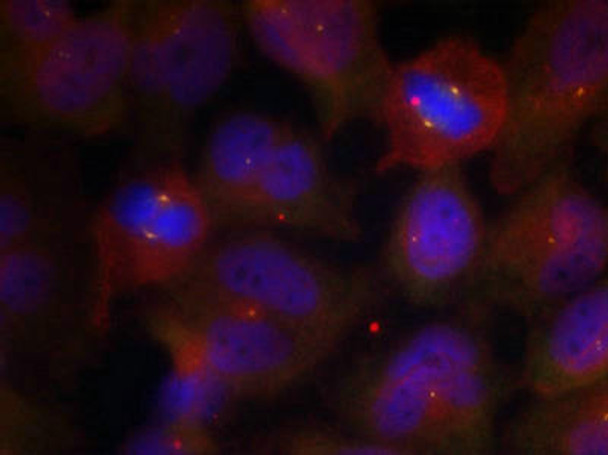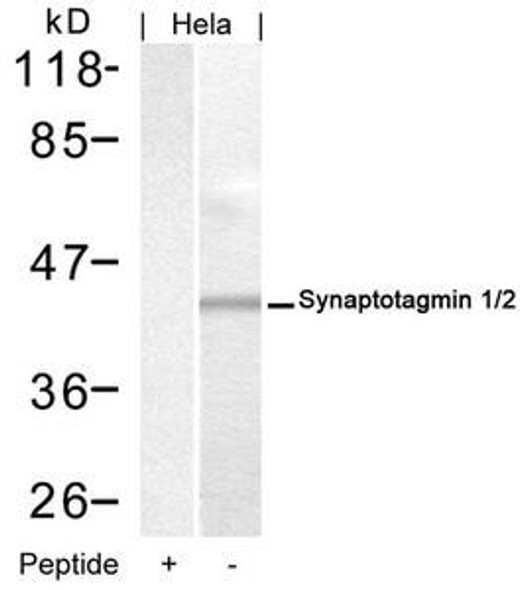Description
Phospho-SYT1/SYT2 (Thr202/199) Antibody (PACO23871)
The Phospho-SYT1/SYT2 (Thr202/199) Antibody (PAC023871) is a valuable tool for researchers studying synaptic transmission and signaling pathways in the nervous system. This antibody, raised in rabbits, is highly specific and reacts with phosphorylated SYT1 and SYT2 proteins, enabling the detection and analysis of these key synaptic proteins in various cell types.SYT1 and SYT2 are critical regulators of neurotransmitter release at synapses, playing a crucial role in the exocytosis of synaptic vesicles. Phosphorylation of Thr202/199 in SYT1/SYT2 is known to modulate their function, affecting synaptic transmission and plasticity.
By targeting this phosphorylation site, researchers can gain insights into the molecular mechanisms underlying synaptic communication and potentially identify new therapeutic targets for neurological disorders.This antibody is validated for use in Western blot applications, making it a versatile tool for studying synaptic function in both normal and pathological conditions. Its high specificity and sensitivity make it an ideal choice for neuroscience research focused on understanding the intricate processes that govern synaptic transmission and plasticity.
| Antibody Name: | Phospho-SYT1/SYT2 (Thr202/199) Antibody (PACO23871) |
| Antibody SKU: | PACO23871 |
| Size: | 100ul |
| Host Species: | Rabbit |
| Tested Applications: | ELISA, IF |
| Recommended Dilutions: | ELISA:1:2000-1:10000, IF:1:100-1:200 |
| Species Reactivity: | Human, Mouse, Rat |
| Immunogen: | Peptide sequence around phosphorylation site of threonine 202/199 (R-K-T(p)-L-N) derived from Human Synaptotagmin 1/2. |
| Form: | Liquid |
| Storage Buffer: | Supplied at 1.0mg/mL in phosphate buffered saline (without Mg2+ and Ca2+), pH 7.4, 150mM NaCl, 0.02% sodium azide and 50% glycerol. |
| Purification Method: | Antibodies were produced by immunizing rabbits with synthetic phosphopeptide and KLH conjugates. Antibodies were purified by affinity-chromatography using epitope-specific phosphopeptide. Non-phospho specific antibodies were removed by chromatogramphy using non-phosphopeptide. |
| Clonality: | Polyclonal |
| Isotype: | IgG |
| Conjugate: | Non-conjugated |
 | Immunofluorescence staining of methanol-fixed Hela cells using Synaptotagmin 1/2 (Phospho-Thr202/199) Antibody. |
| Background: | The synaptotagmins are integral membrane proteins of synaptic vesicles thought to serve as Ca(2+) sensors in the process of vesicular trafficking and exocytosis. Calcium binding to synaptotagmin I participates in triggering neurotransmitter release at the synapse |
| Synonyms: | SYT1/2; SytI/II; Synaptotagmin I/II; P65; SYT |
| UniProt Protein Function: | SYT1: an integral membrane protein of synaptic vesicles thought to serve as a Ca(2+) sensor in the process of vesicular trafficking and exocytosis. Calcium binding to synaptotagmin I participates in triggering neurotransmitter release at the synapse. Binds acidic phospholipids with a specificity that requires the presence of both an acidic head group and a diacyl backbone. A Ca(2+)-dependent interaction between synaptotagmin and putative receptors for activated protein kinase C has also been reported. It can bind to at least three additional proteins in a Ca(2+)-independent manner; these are neurexins, syntaxin and AP2. |
| UniProt Protein Details: | Protein type:Membrane protein, integral; Vesicle; Calcium-binding Chromosomal Location of Human Ortholog: 12cen-q21 Cellular Component: neuron projection; plasma membrane; synaptic vesicle; synaptic vesicle membrane Molecular Function:calcium ion binding; calcium-dependent phospholipid binding; clathrin binding; low-density lipoprotein receptor binding; phosphatidylinositol binding; phosphatidylinositol-4,5-bisphosphate binding; protein binding; SNARE binding; syntaxin-1 binding Biological Process: calcium ion-dependent exocytosis of neurotransmitter; detection of calcium ion; glutamate secretion; neurotransmitter secretion; positive regulation of synaptic transmission; protein homooligomerization; regulation of calcium ion-dependent exocytosis; regulation of exocytosis; regulation of synaptic transmission, glutamatergic; synaptic transmission; synaptic vesicle endocytosis; vesicle fusion |
| NCBI Summary: | The synaptotagmins are integral membrane proteins of synaptic vesicles thought to serve as Ca(2+) sensors in the process of vesicular trafficking and exocytosis. Calcium binding to synaptotagmin-1 participates in triggering neurotransmitter release at the synapse (Fernandez-Chacon et al., 2001 [PubMed 11242035]).[supplied by OMIM, Jul 2010] |
| UniProt Code: | P21579 |
| NCBI GenInfo Identifier: | 135086 |
| NCBI Gene ID: | 6857 |
| NCBI Accession: | P21579.1 |
| UniProt Secondary Accession: | P21579,Q6AI31, |
| UniProt Related Accession: | P21579 |
| Molecular Weight: | 47,573 Da |
| NCBI Full Name: | Synaptotagmin-1 |
| NCBI Synonym Full Names: | synaptotagmin 1 |
| NCBI Official Symbol: | SYT1 |
| NCBI Official Synonym Symbols: | P65; SYT; SVP65 |
| NCBI Protein Information: | synaptotagmin-1 |
| UniProt Protein Name: | Synaptotagmin-1 |
| UniProt Synonym Protein Names: | Synaptotagmin I; SytI; p65 |
| Protein Family: | Synaptotagmin |
| UniProt Gene Name: | SYT1 |
| UniProt Entry Name: | SYT1_HUMAN |
| Secondary Antibody |
| Anti-HRP Goat Anti-Rabbit IgG (H+L) Antibody (CABS014) |
| Recommended Products |
| Anti-FITC Goat Anti-Rabbit IgG (H+L) Antibody (CABS011) |
| Anti-HRP-conjugated Beta Actin Antibody (CABC028) |











